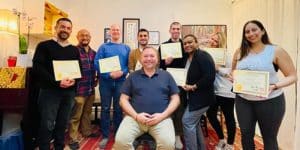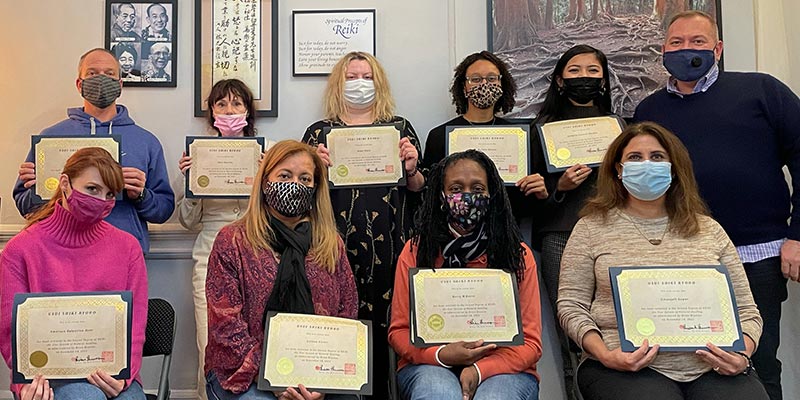I was in the grocery store last week waiting in line to pay. A woman in the line next to me started talking to me and asked me what I did. This happens pretty often, and I usually respond to people, “I do Reiki.” The woman immediately replied that she knew what Reiki is, and had just taken a Reiki class online. In fact, she had become a Reiki Master.
I congratulated her, and asked her the questions I always ask, “What style of Reiki did you learn? What is your lineage?” She responded, “I don’t know. They just called it Reiki. What does lineage mean? The class was only about two hours so I don’t think I caught the teacher’s name.” I asked her, “Have you ever received a Reiki treatment? Have you ever done Reiki on yourself or anyone else?” And the answer to both questions was, “No.” In fact, the teacher hadn’t told her she could do Reiki on herself.
To me this underscores the biggest problem with learning Reiki in an online class. Most of the classes are very brief and the students often don’t make a direct connection with the lineage or even the teacher who taught the class. They don’t receive a hands-on treatment from other students, so they don’t know what Reiki feels like. They don’t give treatments to anyone else, so they don’t have any experience practicing Reiki.
What’s in a name?
Furthermore, this unethical teacher of the online class had told the students in two hours she had made them “Reiki Masters.” Of course, any reasonable buyer knows that if it sounds too good to be true, it probably is. And in this case no reasonable adult would call themselves a master of anything in two hours. Nobody can master anything if they haven’t practiced for years. I completed my three and a half year, 2,000-hour Master training and was officially a Reiki Master for more than five years before I felt somewhat masterly in my practice and had the confidence to call myself a Reiki Master. In those five years I had treated clients for about 10,000 hours and had taught almost 100 Reiki classes. For someone to take a two-hour class and believe they have mastered a practice is wishful thinking.
Time is important
 My teacher taught me that the Reiki class should be at least 12 to 16 hours, and during the level one class students should receive at least four initiations (also called attunements), which must be at least six hours apart. Using this method passed down through the generations from Mikao Usui, the founder of Reiki, I am sure that my students are receiving the strongest possible connection to the source of Reiki. Between the attunements, we practice Reiki on each other. Each student in my class will give nine to twelve Reiki treatments and receive at least three Reiki treatments from the other students. In this way I can be sure that no student leaves the class unprepared to treat other people. I also teach my students the Reiki self-treatment, a daily practice I ask them to do for 90 days following the class.
My teacher taught me that the Reiki class should be at least 12 to 16 hours, and during the level one class students should receive at least four initiations (also called attunements), which must be at least six hours apart. Using this method passed down through the generations from Mikao Usui, the founder of Reiki, I am sure that my students are receiving the strongest possible connection to the source of Reiki. Between the attunements, we practice Reiki on each other. Each student in my class will give nine to twelve Reiki treatments and receive at least three Reiki treatments from the other students. In this way I can be sure that no student leaves the class unprepared to treat other people. I also teach my students the Reiki self-treatment, a daily practice I ask them to do for 90 days following the class.
Is it possible online?
We know from her diaries that Hawayo Takata, the woman who brought Reiki from Japan to America, did a few times give Reiki initiations remotely to students in moments of great need. Her caveat was that the next time they met she would perform the initiations in person, hand-to-hand. This was a compromise she made when the students were in crisis and needed the power of Reiki in their hands to help them through it. In retrospect, she told her granddaughter Phyllis Lei Furumoto, she wished she hadn’t. She didn’t like the results she saw, and she wouldn’t do it again. Yet today, the majority of Reiki classes are taught online, or worse, through pre-recorded videos that students simply watch without any interaction with a living teacher.
What I practice and teach
I practice and teach Usui Shiki Ryoho. My teacher John Gray learned it from Hawayo Takata, she learned it from Chujiro Hayashi, and he learned Usui Reiki Ryoho from Mikao Usui, the founder of Reiki. Usui asked Hayashi to simplify the practice, and Hayashi fulfilled his teacher’s wishes, creating the hand positions we use today. He renamed this simplified practice Usui Shiki Ryoho to show that it was changed from the original Usui Reiki Ryoho. The teachings, the stories, the form of treatment, have remained largely unchanged since Hayashi initiated Hawayo Takata as a Reiki Master in 1938. I know where my Reiki comes from, and I know the origin of every part of my practice. When I teach the class and tell the stories, I am able to connect my students to the energy of the lineage bearers of the practice, a potent form of initiation in its own right.
During classes, as I give each initiation or attunement, I watch the students begin to change. By the end of a class, they look very different and their energy is brighter and calmer than when the class began. This happens primarily because of the four attunements being delivered over the course of several days. Most online classes give a single attunement and say, “It’s very strong so we only have to give one.” Also wishful thinking at best, and a scam at worst. Students in these classes will not receive most of the benefits that are possible from a traditional in-person Reiki class.
It is the face-to-face connection with a living teacher that adds so much power to my students’ Reiki practice, and I have personally experienced that connection doesn’t happen in the same way over zoom. Reiki has traditionally been passed from hand-to-hand, from the hands of the Master to the hands of the students. I took an oath to my master that I would keep the class format and initiations unchanged, and I intend to honor that commitment.







